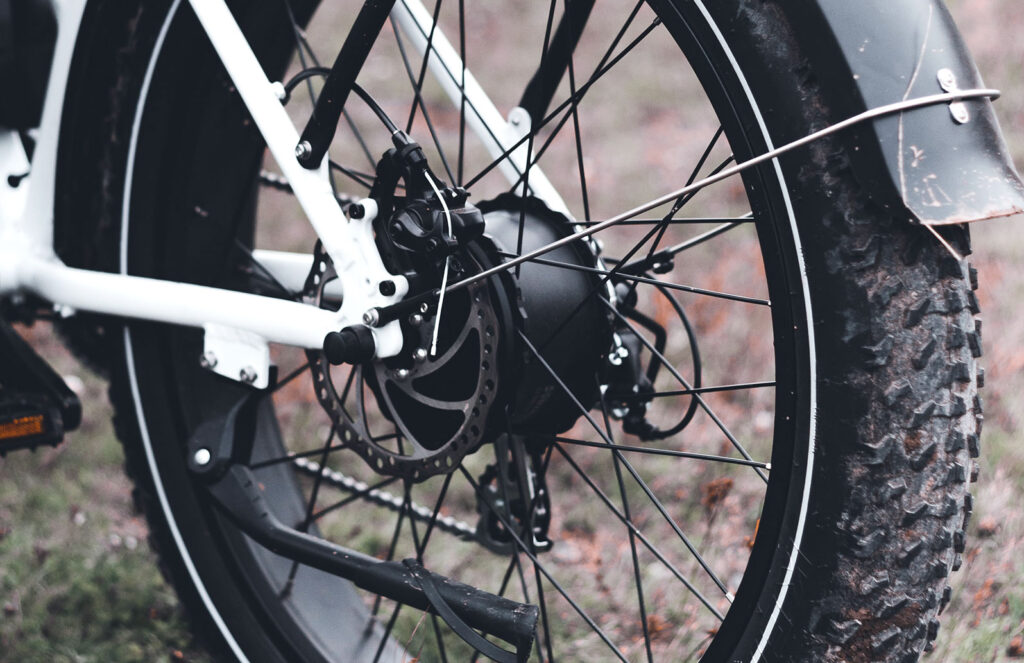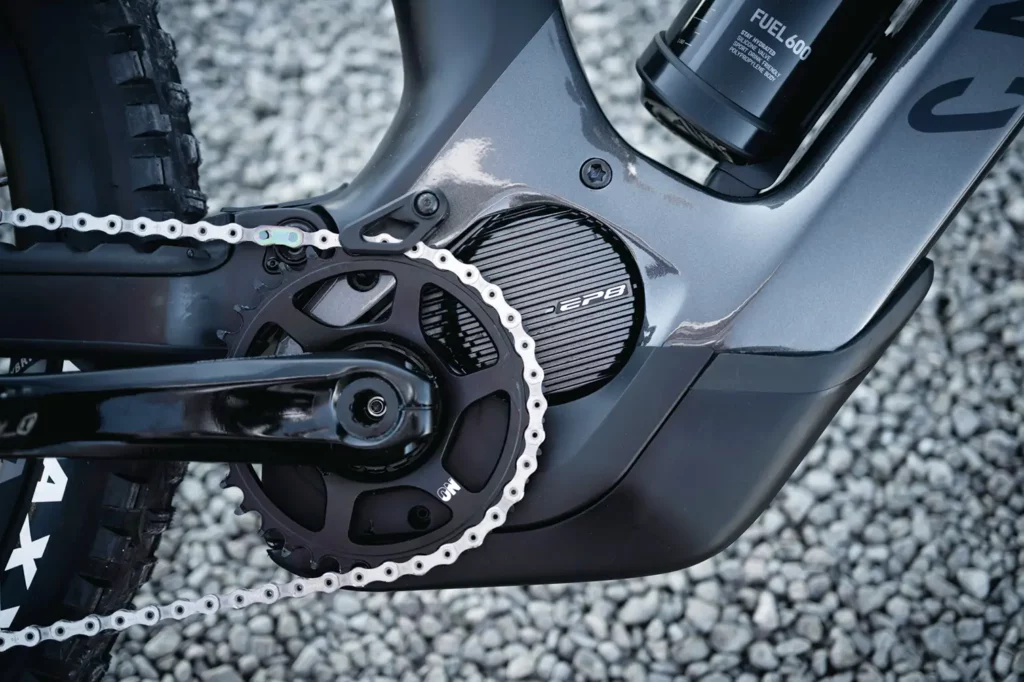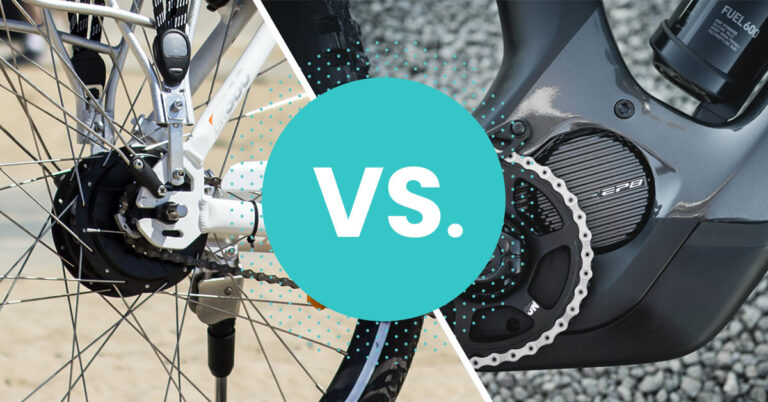Generally speaking, hub motors are cheaper to make and have less responsive handling, whereas mid-drive motors are more fun to ride but require a lot more maintenance. There’s more to it, as you will discover in this article—not all hub-motor electric bikes are cheap and cheerful, and mid-drive motors aren’t always the best for your riding needs.
Here are the most important things you need to know about mid-drive and hub-drive electric bike motors.

What is a Hub Motor Electric Bike?
Multiple electric bike manufacturers make high-quality e-bikes with hub motors. In the US, perhaps the most famous is Rad Power Bikes, which began as an electric bike manufacturer (unlike Giant, Trek, and Specialized) and is now considered a byword for reliable, fun-to-ride e-bikes.
A hub motor sits in the center of either the front or rear wheel and when an impulse is sent from the controller, makes the wheel turn. Though you can get front-hub motors in e-bike conversion kits, many e-bike makers sell their machines with rear-hub motors as they are easier to control than front-hub motors.
There are two types of hub motors: the direct drive motor and the geared hub motor. The very cheapest electric bikes will have direct drive motors whose only moving parts are the internal bearings. These types of motors could, in theory, run forever.
On today’s electric bikes, you’ll more commonly find that the hub motor is a ‘geared hub motor.’ This type of motor has a system of planetary gears so the motor itself runs at a lower speed. With the gears, it delivers more power at a greater efficiency than a direct drive motor.
Thanks to those gears, however, geared hub motors will have a shorter lifespan than direct drive motors.
Throttles
With a few exceptions, most throttle-powered electric bikes will have hub motors. Using a lever or twist-handle throttle, your hand tells the controller to give power to the motor and it will send out a signal to the motor to give a proportionate amount of power.
Some mid-drive systems come with throttles as an option. As we will see later, these can add more maintenance issues to a system that already requires a lot more maintenance than that of a hub motor with a throttle.

What is a Mid-Drive eBike?
A mid-drive electric bike has a motor installed on the bottom bracket where the pedals are attached. It delivers power directly to the pedal drivetrain as your legs would when pedaling, and it is generally a purely pedal-assist system.
There are several advantages to a mid-drive:
- The riding experience is more natural as the response to the act of pedaling is near-instant.
- With the weight of the motor being close to the bike’s center of gravity, it has a similar feel to an analog bike and can be more fun.
- They are more efficient on battery use because they use a similar principle of driving the bike to your legs, only turning at the speed your legs would at fewer revolutions per minute than a hub motor.
- They require a smaller battery for a given range than on a hub-motor electric bike, saving weight.
- The most common maintenance requirement is fixing your tire. On a mid-drive, this is a process very similar to that of an analog bike. You don’t need to unplug the power cable as you would on a hub motor.
However, the motor powering the bike through the pedal drivetrain does mean you will have a big, thick chain that will be prone to breaking and will certainly wear out more quickly than on an analog bike. You will have to replace the cassette and, often enough, the front cog every few thousand miles.
As you can see above, the idea of adding a throttle to an already stressed system could be like throwing gas on a fire. A throttle putting power through the chain could stress it a lot more than pedaling, and the stretches, breaks, and maintenance required go up considerably.
What is the Difference Between a Mid Drive and Hub Motor eBike?
When your battery runs out, or perhaps when you want to save a bit of battery for the final miles home, it is better to have a hub motor than a mid-drive. With the exception of the Fazua Evation e-bike motor, pedaling without power on a mid-drive motor can be like wading through maple syrup. This is because your legs are pushing against the motor itself as well as its internal gearbox as you pedal.
Because of this, not all premium electric bikes have mid-drive motors. For example, the Trek Domane+ AL5 has a rear-hub motor that, when switched off, offers near-zero resistance to the rider. On a bike like this, you can climb a mountain without power support on a training ride, then have enough juice to get you back home after abusing your legs on the climb.
Cost
With major exceptions proving the rule, however, lower-cost electric bikes will have hub motors and mid-drive e-bikes will be more expensive. This is down to a variety of factors, not least that the frames have to be specially made to accommodate the mid-drive motors.
Many hub motor e-bikes still have integrated batteries in their downtubes (meaning the frame will still be different from an analog bike), but increased cost again comes from other technology on more expensive machines.
Cadence and Torque Sensors
Generally, cadence sensors are on hub motor systems and torque sensors are on mid-drive systems. Cadence sensors are a ring of magnets that tell the controller whether the bike is being pedaled. If it is, the controller powers the motor.
Torque sensors can cost 10x more than a cadence sensor. These estimate the force being put through the pedals, and the controller then puts a proportionate amount of power out of the motor, so when you pedal harder up a hill you get more power from the motor.
As you can imagine, when it comes to computing power the controller with a torque sensor will be significantly more complex than the one with a cadence sensor. With aspects like these, the costs of making a mid-drive system mount up by degrees.
How to Choose the Right eBike Motor
From what we have shown above, there are pros and cons to each type of motor.
Hub Motor Pros:
- Has fewer maintenance requirements than a mid-drive
- Less friction means that you can ride home on a dead battery
- Can have a throttle as well as pedal assist
- Requires less expensive technology
- Is generally cheaper yet will still get you up those hills
Hub Motor Cons
- Geared hub motors have a shorter lifespan
- Direct-drive hub motors have lower power and efficiency
Mid-Drive Motor Pros
- On a mountain bike, handles better on rough terrain
- Has a more natural riding feel
- Will have other supporting technology to refine the riding feel
Mid-Drive Motor Cons
- Typically more expensive
- Is pedal assist only
With these in mind, choosing the right electric bike motor will come down to what you, as a cyclist, want from an e-bike. If you are older or recovering from health problems or an injury, then it may make sense to buy an electric bike with a throttle and rear-hub motor.
If you are more of a cycling purist who is willing to put up with the maintenance issues that come with a mid-drive motor, and if you’re willing to spend more on an e-bike, the mid-drive could be your thing. As we discussed above, there are exceptions to many of those rules too, so it might be a decision made as much with the heart as it is with the head.



